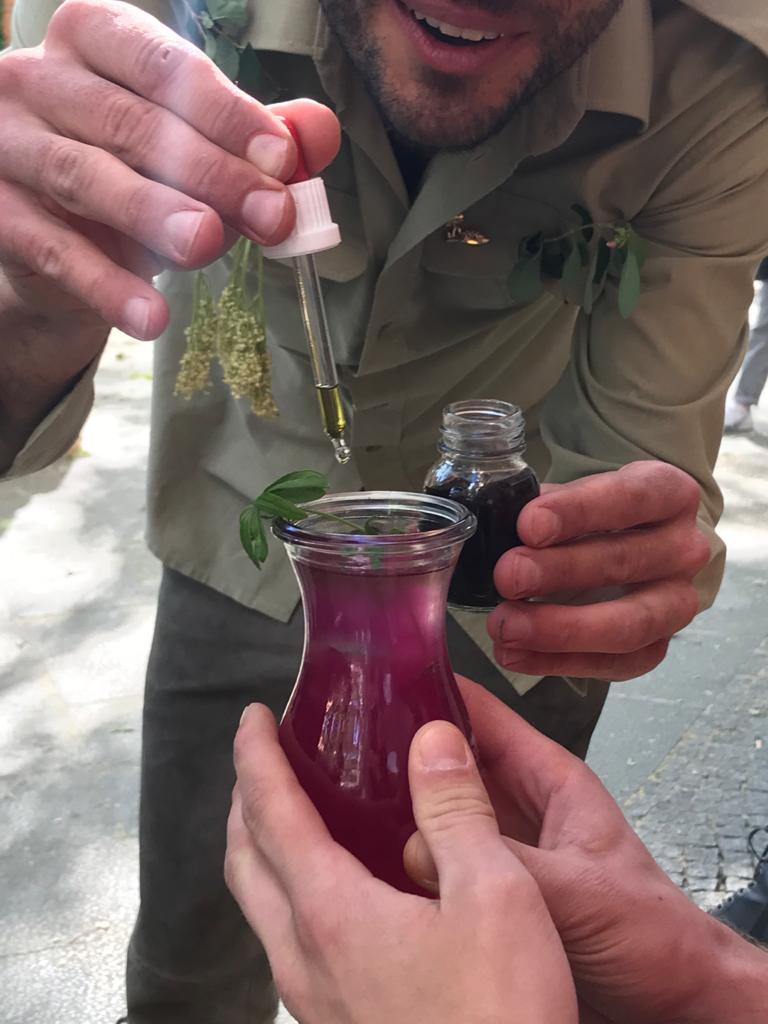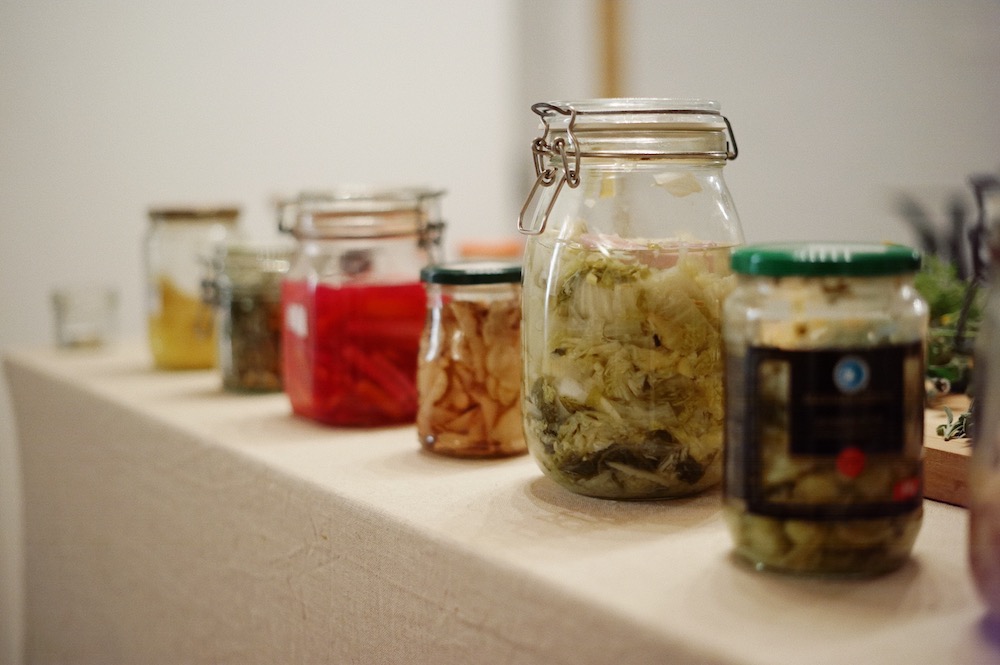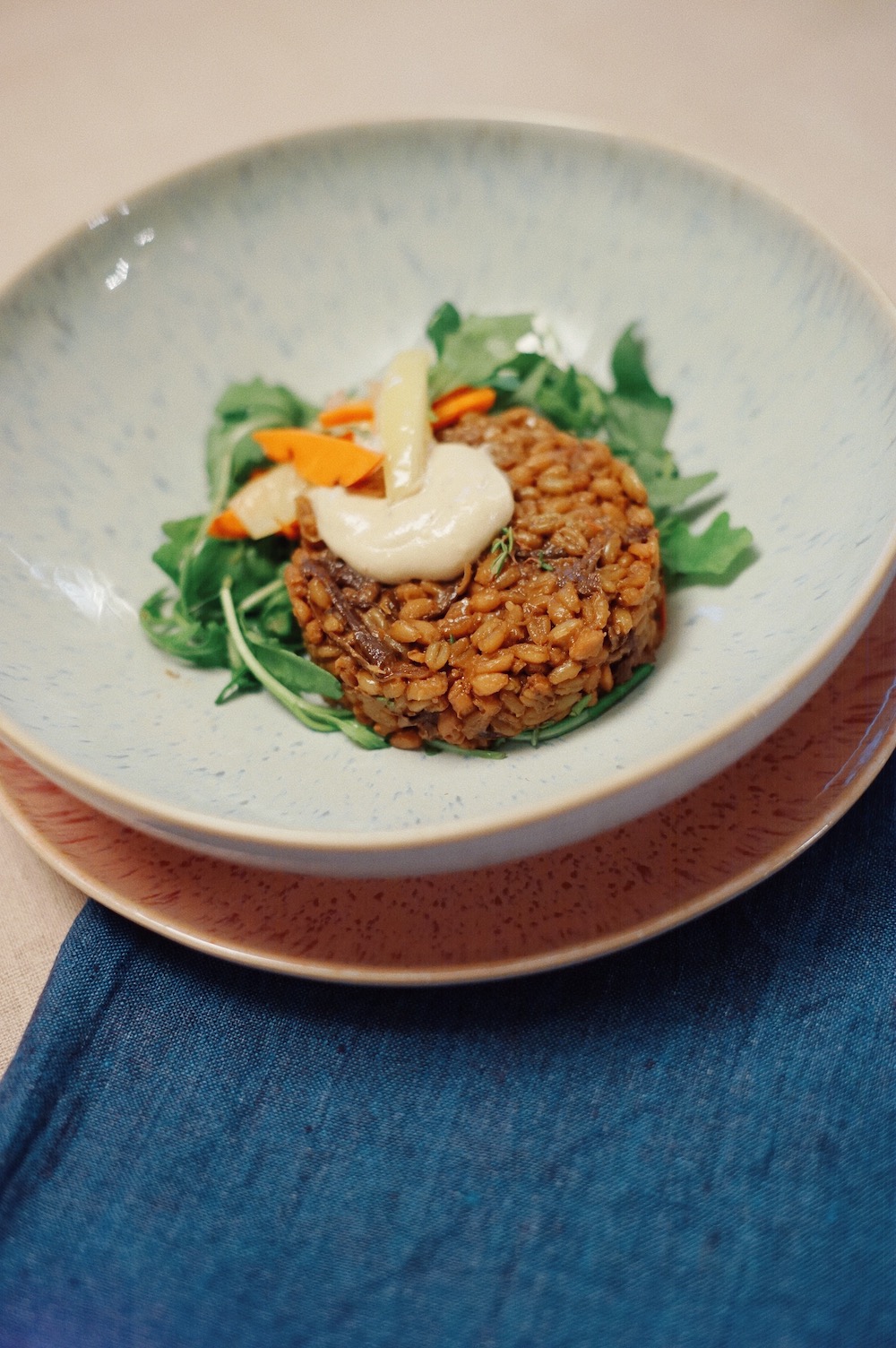Three core principles guide our work at Edible Alchemy—Health, Ecology and Taste. Our philosophy is that the three go hand in hand in hand, meaning they are interdependent; symbiotic, if you will. Some might call our approach holistic. Beneficial. Or wholesome. Regardless, the benefits for people and for nature are undeniable.
On our blog, we recently chose to explore fermentation in the context of epicureanism. Indeed, Epicurus himself also believed that a healthy, a good and an indulgent life are one.
For these reasons, and because the whole is greater than the sum of its parts, you will come to discover overlapping elements in all three sections…

Health
Fermentation Aids Digestion
Fermentation makes many foods more digestible. In some cases, nutrients become more accessible; in others, toxins are broken down. And sometimes, fermentation facilitates both processes simultaneously. Here are three examples (of many):
1. Raw cabbage is difficult to digest, which becomes (unpleasantly) noticeable in the digestive tract. Because we are not cows with four stomachs, it is good practice to let the breakdown of complex carbohydrates and proteins take place in a vessel separate from our stomachs. In a mason jar, for example! Furthermore, fermentation makes many nutrients, such as riboflavin and niacin, bioavailable. This means that these nutrients are easily and readily absorbable when they enter the gut—the hard work has already been done.
2. Almost all legumes have too much folic acid. This hinders the absorption of iron and magnesium. The act of soaking and fermenting legumes activates enzymes that help break down and reduce the high amount of folic acid. These processes for nutrient absorption and digestibility are just as important when preparing chickpeas or lentils as boiling them. And no one would really think of eating them raw, would they.
3. Even in the form of ground flour, grains are very difficult for humans to digest. Baking bread with one strain of industrial yeast (the majority of the bread on the market!) only does half the job. Using a sourdough starter, which typically contains over 30 different yeasts and bacteria, helps break down grains in a highly digestible way. Their complex carbohydrates are made more accessible to us as a result. Thus, we can highly recommend Cornelius, our 155-year-old sourdough starter.

Probiotic, not Antibiotic
Fermentation brings foods to life! For decades, bacteria was heavily frowned upon. In the culinary world, in modern medicine, anywhere really. Luckily, in recent years, people have begun to grasp that killing off everything that lives doesn’t make us healthy but makes us sick. Probiotics, the friendly bacteria in our ferments, are the opposite of antibiotics. And the vast majority of bacteria and yeasts around us are friendly.
Unfortunately, in today’s Western fast-food and supermarket culture, Grandma’s mason jars and sauerkraut barrels are nowhere in sight. Why? Because thanks to preservatives and ultra-high temperatures, everything has a nice, long shelf life anyway. Foods in supermarkets are, for the most part, not antibiotic. But the problem is, they are also not probiotic. They are simply dead. The result? Our microbiomes are depleted.
Food as Medicine
“Let your food be your medicine, and medicine be your food.” Yes, the Ancient Greeks (Hippocrates) got it right once again. Probiotic foods are better than probiotic pills. One of many reasons is that probiotic pills lack prebiotics (the substances that make probiotics work in the first place), specifically fiber, which stimulates your small intestine activity. With whole foods, you get the whole package.
Healthy Microbiome = Robust Immune Defense!
Did you know that about 70% of immune cells are formed in your gut? A healthy gut microbiome is a prerequisite for a healthy immune system. In the long run, the types and the number of bacteria, i.e. quality and quantity, can be increased by a diverse diet. At the moment, however, research is not yet conclusive on how long that process takes.
There is some so-called ‘reverse evidence’, i.e. that the microbiome is depleted if your diet primarily contains processed/fast food (see above!). The trouble is: it’s complicated. Why? Well, we’re talking about approximately 1,000 different species and about 100 trillion microbes in total, in healthy people. 100,000,000,000,000! Interacting with each other, on top of everything else!

The Second Brain
In recent years, the gut is making a name for itself in scientific communities as the body’s “second brain”. As it turns out, substances that researchers once naturally assumed were produced in the brain actually come from the gut and are sent up to the brain via the vagus nerve. This completes the so-called “gut-brain axis”. Examples of these substances include dopamine and serotonin. The stuff good moods are made of; your natural antidepressants! In Western culture, metaphorically speaking, we tend to talk of having “a heavy heart” or “a broken heart” when we are sad. In many other cultures, this emotional state is expressed through references to the gut.
In an animal experiment, the microbiome of a curious mouse was swapped for that of a depressed/anxious mouse. Lo and behold, this resulted in the reversal of the mouse’s behavior. The same proved to be true when swapping the microbiome of an active, fit mouse with that of a lethargic, overweight one: behavior and even eating patterns follow suit!
Everything in Moderation
“The dose makes the poison.” This time, it’s not a Greek but a Swiss thinker who leads the way: Paracelsus. We sometimes have to remind over-enthusiastic aspiring edible alchemists who have, for example, firmly decided to drink an entire liter of kombucha every day, about the importance of moderation. Too much sugar and too much histamine. Eating a large bowl of kimchi a day? Too much salt. It’s always better for the body to have a little bit of everything! Plus, kombucha, kimchi & co. are very nutrient-dense, even in small doses. It’s better to get a different dose of another ferment with other nutrients/nutrient combinations. Your taste buds, too, will be delighted with the variety. This is a typical example of how healthy and delicious foods go hand in hand.
Also, remember there is no one superfood. Not even in the realm of fermentation. However, what is super is when you consume many different raw, many different cooked, and many different fermented foods in one sitting. #3Deating

Ecology
Rescuing Foods
So many raw or cooked vegetables go off or end up in the trash. Fermentation avoids food waste. Thus, at Edible Alchemy, we like to consider it “glumpster diving”, alias the more glamorous version of dumpster diving.
How is glumpster diving better than dumpster diving, ecologically? Concerning crops, we have to go into a little more detail: When any given crop is “in season”, a large volume of that nut, fruit or vegetable is harvested at once. Even at the lowest prices, farmers/retailers don’t manage to sell such large quantities in short timespans. Thus, in industrial agriculture, large volumes are kept in cold storage units for months to avoid spoilage and allow them to market things as “fresh” throughout the year. This is quite a CO2 intensive practice, as you can imagine. If, instead, food is expertly fermented at the point of harvest, lactic fermentation takes the reins. Food is saved without having to eat it all at once or pump carbon into the atmosphere. Even limp vegetables magically become crisp again and can be consumed for months on end—that is the beauty of edible alchemy!

Central Europe has so many delicious things to offer in (almost) every season: berries, stone fruits, legumes, grains, cabbages, beets, pumpkins…the list goes on. If you ferment what is available in abundance, you will have fewer reasons to buy other fruits that aren’t in season. These are usually a nutritional and ecological disaster because they are harvested when they are still very unripe and then flown or shipped from far away lands. How is it possible that a whole box of mangoes only costs €2 at Maybachufer?
Thanks to fermented foods, you can have a diverse diet while also eating seasonally, regionally and ecologically all-year-round.
Baked goods are also high up on the list of foods that get binned in retail, bakeries and households because it isn’t “fresh”. Sourdough bread, however, doesn’t go bad quickly outside the fridge. It gets hard, at most. And then you can still make croutons, dumplings or kvass out of it….
Globalization’s Friendly Side
We find foreign cultures and their exotic cuisines insanely fascinating. Globalization has two sides and one of them has a bad name for good reasons. Suppose, however, we only import the cultural techniques or bring home a few grams of bacterial cultures, spices or spores from faraway countries, but source all our ingredients locally. In this case, we can ferment and cook exotically but still minimise our ecological footprint! One gram of spores from Indonesia or Japan + your knowledge + local legumes = kilos of tempeh & miso. In this way, we’re able to embrace globalization’s friendlier side in all its glory!
Herbs vs. Weeds
Let’s eat more weeds! Or forage herbs that grow in abundance. What makes a weed a weed anyway? Dandelion, nettle, ground elder, chickweed, daisies, yarrow, gallant soldier, ground ivy—hipsters call them “microgreens”. They taste better than industrial lettuce, have more nutrients, and have zero ecological footprint. The more, the merrier.

Taste
Umami
Umami (from Japanese ume “delicious”) is the round taste of ripe ferments and—officially and scientifically—one of our five tastes: sweet, sour, salty, bitter and umami. Why do we need a Japanese word? Because, unfortunately, very little umami is going on in modern Western cuisine. There is far too much reliance on meat, (deep)fried foods and highly processed glutamate (MSGs, Marmite, the cheap Asian takeout around the corner).
Many Asian cuisines know there are also plenty of ways of creating vegan umami: kimchi is umami, miso is umami, sake and ripe ginger beer are umami. You just have to know how to get the alchemical (enzymatic and microbial) process going and then give it a little time to work its magic.

Fusion
A wide variety of fermentation techniques exist all over the world. New fusion cooking creates exotic flavors by applying foreign cultural techniques to local crops. Take Brandenburg’s magnificent stone fruits, such as plums. Salt them, ferment them, dry them, and you end up with mind-blowing “Japanese” umeboshi: they are sweet, sour, salty and umami all at the same time! Oh yes, and of course, they are also probiotic and good for digestion.
The Third Dimension of Culinary Composition
Fermentation is the third dimension in cooking. With raw and cooked ingredients, dishes are not one-, but, well, two-dimensional. This is not some new or revolutionary insight on our part. Once upon a time, the addition of fermented foods to people’s plates was just as normal as the act of combining the five types of taste.
Sauces and condiments, like ketchup, mustard or Tabasco, side dishes, like kimchi, cabbage or pickles, were all fermented and probiotic before they became commercialised. Today, they are mostly preserved using (non-probiotic) vinegar or (even worse) artificial preservatives, and MSG is added for a flavour boost. It’s just not the same. Neither for the gut, nor for the taste buds.
The Nordic Food Revolution in award-winning cuisine is only now bringing the third dimension back to the menu. Thank you, Noma! In contrast, French Nouvelle Cuisine, where everything must always be fresh, has become somewhat of an old hat. Gault & Millau, the most renowned high-end restaurant guide alongside the Michelin Guide, had pickled vegetables on its blacklist of no-gos until 2014.
But how did it come to this, and why did the wind change? We are very much looking forward to having a philosophical discussion about this at our next 52 Seasons Dinner!

